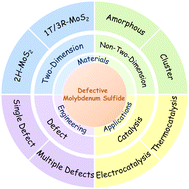Recent advances in defect-engineered molybdenum sulfides for catalytic applications
Abstract
Electrochemical energy conversion and storage driven by renewable energy sources is drawing ever-increasing interest owing to the needs of sustainable development. Progress in the related electrochemical reactions relies on highly active and cost-effective catalysts to accelerate the sluggish kinetics. A substantial number of catalysts have been exploited recently, thanks to the advances in materials science and engineering. In particular, molybdenum sulfide (MoSx) furnishes a classic platform for studying catalytic mechanisms, improving catalytic performance and developing novel catalytic reactions. Herein, the recent theoretical and experimental progress of defective MoSx for catalytic applications is reviewed. This article begins with a brief description of the structure and basic catalytic applications of MoS2. The employment of defective two-dimensional and non-two-dimensional MoSx catalysts in the hydrogen evolution reaction (HER) is then reviewed, with a focus on the combination of theoretical and experimental tools for the rational design of defects and understanding of the reaction mechanisms. Afterward, the applications of defective MoSx as catalysts for the N2 reduction reaction, the CO2 reduction reaction, metal–sulfur batteries, metal–oxygen/air batteries, and the industrial hydrodesulfurization reaction are discussed, with a special emphasis on the synergy of multiple defects in achieving performance breakthroughs. Finally, the perspectives on the challenges and opportunities of defective MoSx for catalysis are presented.

- This article is part of the themed collection: Recent Review Articles


 Please wait while we load your content...
Please wait while we load your content...